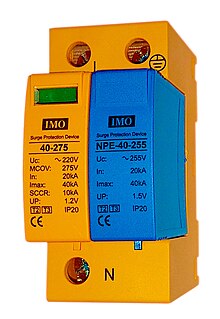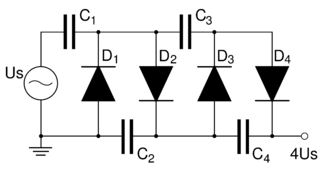
An ignition magneto, or high-tension magneto, is a magneto that provides current for the ignition system of a spark-ignition engine, such as a petrol engine. It produces pulses of high voltage for the spark plugs. The older term tension means voltage.

A spark gap consists of an arrangement of two conducting electrodes separated by a gap usually filled with a gas such as air, designed to allow an electric spark to pass between the conductors. When the potential difference between the conductors exceeds the breakdown voltage of the gas within the gap, a spark forms, ionizing the gas and drastically reducing its electrical resistance. An electric current then flows until the path of ionized gas is broken or the current reduces below a minimum value called the "holding current". This usually happens when the voltage drops, but in some cases occurs when the heated gas rises, stretching out and then breaking the filament of ionized gas. Usually, the action of ionizing the gas is violent and disruptive, often leading to sound, light and heat.

A flashtube (flashlamp) is an electric arc lamp designed to produce extremely intense, incoherent, full-spectrum white light for a very short time. A flashtube is a glass tube with an electrode at each end and is filled with a gas that, when triggered, ionizes and conducts a high-voltage pulse to make light. Flashtubes are used most in photography; they also are used in science, medicine, industry, and entertainment.

A surge protector (or spike suppressor, surge suppressor, surge diverter, surge protection device or transient voltage surge suppressor is an appliance or device intended to protect electrical devices from voltage spikes in alternating current circuits. A voltage spike is a transient event, typically lasting 1 to 30 microseconds, that may reach over 1,000 volts. Lightning that hits a power line can give a spike of over 100,000 volts and can burn through wiring insulation and cause fires, but even modest spikes can destroy a wide variety of electronic devices, computers, battery chargers, modems and TVs etc, that happen to be plugged in at the time. Typically the surge device will trigger at a set voltage, around 3 to 4 times the mains voltage, and divert the current to earth. Some devices may absorb the spike and release it as heat. They are generally rated according to the amount of energy in joules they can absorb.

A voltage multiplier is an electrical circuit that converts AC electrical power from a lower voltage to a higher DC voltage, typically using a network of capacitors and diodes.

A pulse-forming network (PFN) is an electric circuit that accumulates electrical energy over a comparatively long time, and then releases the stored energy in the form of a relatively square pulse of comparatively brief duration for various pulsed power applications. In a PFN, energy storage components such as capacitors, inductors or transmission lines are charged by means of a high-voltage power source, then rapidly discharged into a load through a high-voltage switch, such as a spark gap or hydrogen thyratron. Repetition rates range from single pulses to about 104 per second. PFNs are used to produce uniform electrical pulses of short duration to power devices such as klystron or magnetron tube oscillators in radar sets, pulsed lasers, particle accelerators, flashtubes, and high-voltage utility test equipment.

In fusion power research, the Z-pinch is a type of plasma confinement system that uses an electric current in the plasma to generate a magnetic field that compresses it. These systems were originally referred to simply as pinch or Bennett pinch, but the introduction of the θ-pinch concept led to the need for clearer, more precise terminology.

The Z Pulsed Power Facility, informally known as the Z machine or Z, is the largest high frequency electromagnetic wave generator in the world and is designed to test materials in conditions of extreme temperature and pressure. It was originally called the PBFA-II and was created in 1985. Since its refurbishment in October 1996 it has been used primarily as an inertial confinement fusion (ICF) research facility. Operated by Sandia National Laboratories in Albuquerque, New Mexico, it gathers data to aid in computer modeling of nuclear weapons and eventual nuclear fusion pulsed power plants.

A Marx generator is an electrical circuit first described by Erwin Otto Marx in 1924. Its purpose is to generate a high-voltage pulse from a low-voltage DC supply. Marx generators are used in high-energy physics experiments, as well as to simulate the effects of lightning on power-line gear and aviation equipment. A bank of 36 Marx generators is used by Sandia National Laboratories to generate X-rays in their Z Machine.

An HVDC converter station is a specialised type of substation which forms the terminal equipment for a high-voltage direct current (HVDC) transmission line. It converts direct current to alternating current or the reverse. In addition to the converter, the station usually contains:

An electronic component is any basic discrete device or physical entity in an electronic system used to affect electrons or their associated fields. Electronic components are mostly industrial products, available in a singular form and are not to be confused with electrical elements, which are conceptual abstractions representing idealized electronic components and elements.

A nitrogen laser is a gas laser operating in the ultraviolet range using molecular nitrogen as its gain medium, pumped by an electrical discharge.

The Cockcroft–Walton (CW) generator, or multiplier, is an electric circuit that generates a high DC voltage from a low-voltage AC or pulsing DC input. It was named after the British and Irish physicists John Douglas Cockcroft and Ernest Thomas Sinton Walton, who in 1932 used this circuit design to power their particle accelerator, performing the first artificial nuclear disintegration in history. They used this voltage multiplier cascade for most of their research, which in 1951 won them the Nobel Prize in Physics for "Transmutation of atomic nuclei by artificially accelerated atomic particles". The circuit was discovered in 1919, by Heinrich Greinacher, a Swiss physicist. For this reason, this doubler cascade is sometimes also referred to as the Greinacher multiplier. Cockcroft–Walton circuits are still used in particle accelerators. They also are used in everyday electronic devices that require high voltages, such as X-ray machines, microwave ovens and photocopiers.

Ányos István Jedlik was a Hungarian inventor, engineer, physicist, and Benedictine priest. He was also a member of the Hungarian Academy of Sciences, and author of several books. He is considered by Hungarians and Slovaks to be the unsung father of the dynamo and electric motor.
A linear transformer driver (LTD) within physics and energy, is an annular parallel connection of switches and capacitors. The driver is designed to deliver rapid high power pulses. The LTD was invented at the Institute of High Current Electronics (IHCE) in Tomsk, Russia. The LTD is capable of producing high current pulses, up to 1 mega amps (106 ampere), with a risetime of less than 100 ns. This is an improvement over Marx generator based pulsed power devices which require pulse compression to achieve such fast risetimes. It is being considered as a driver for z-pinch based inertial confinement fusion.

Capacitors have many uses in electronic and electrical systems. They are so ubiquitous that it is rare that an electrical product does not include at least one for some purpose.
MAGPIE is a pulsed power generator based at Imperial College London, United Kingdom. The generator was originally designed to produce a current pulse with a maximum of 1.8 million amperes in 240 nanoseconds. At present the machine is operated with a maximum current of approximately 1.4 million amperes and operates as a z-pinch facility.

ATLAS-I, better known as Trestle, was a unique electromagnetic pulse (EMP) generation and testing apparatus built between 1972 and 1980 during the Cold War at Sandia National Laboratories near Kirtland Air Force Base in Albuquerque, New Mexico.
An electromagnetic pulse (EMP), also a transient electromagnetic disturbance (TED), is a brief burst of electromagnetic energy. Depending upon the source, the origin of an EMP can be natural or artificial, and can occur as an electromagnetic field, as an electric field, as a magnetic field, or as a conducted electric current. The electromagnetic interference caused by an EMP disrupts communications and damages electronic equipment; at higher levels of energy, an EMP such as a lightning strike can physically damage objects such as buildings and aircraft. The management of EMP effects is a branch of electromagnetic compatibility (EMC) engineering.
IEC 61000-4-5 is an international standard by the International Electrotechnical Commission on surge immunity. In an electrical installation, disruptive surges can appear on power and data lines. Their sources include abrupt load switching and faults in the power system, and induced lightning transients from an indirect lightning strike. It necessitates the test of surge immunity in electrical or electronic equipment. IEC 61000-4-5 defines test set-up, procedures, and classification levels.
















